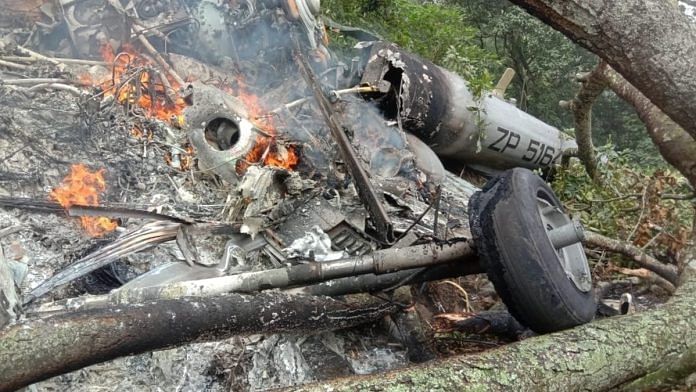New Delhi: Sudden cloud cover, which led to Controlled Flight Into Terrain (CFIT), has been identified as the reason behind the helicopter crash last month which claimed the lives of 14 people, including India’s first Chief of Defence Staff (CDS) Gen. Bipin Rawat, ThePrint has learnt.
Air Chief Marshal V.R. Chaudhari, head of the Indian Air Force, along with Air Marshal Manvendra Singh, Air Officer Commanding-in-Chief of the Training Command, who headed the tri-service inquiry into the crash that took place in the forest near Coonoor in Tamil Nadu, briefed Defence Minister Rajnath Singh on the probe Wednesday.
Defence sources told ThePrint that the probe has ruled out any technical malfunction, sabotage or any kind of missile attack as reasons for the crash.
The probe looked into multiple aspects of the crash, including examining the helicopter structure, Flight Data Recorder (FDR) and the Cockpit Voice Recorder (CVR), both of which together are known as the ‘black box’ of an aircraft.
Sources said data from the FDR and the CVR revealed that there was nothing to indicate any kind of disorientation of the pilots — Wing Commander Prithvi Singh Chauhan and Squadron Leader Kuldeep Singh.
“This was a CFIT due to sudden cloud cover which had moved in,” a source said.
The US’ Federal Aviation Administration Safety defines CFIT “as an unintentional collision with terrain (the ground, a mountain, a body of water, or an obstacle) while an aircraft is under positive control”.
It adds that most often, the pilot or crew is unaware of the looming disaster until it is too late, and it most commonly occurs in the approach or landing phase of a flight.
Also read: Process to find Gen. Rawat’s successor as CDS begins, these are the likely options before govt
No distress call made to ground station
As reported by ThePrint earlier, the probe team also analysed a video shot by a group of tourists which shows the helicopter disappearing into clouds, seconds before the crash.
Sources explained that there are Standard Operating Procedures (SOPs) that the pilots are supposed to take whenever they are faced with a sudden change in weather.
News agency ANI reported that the probe report said the crew decided to fly out of the cloud “rather than landing and hit a cliff in the process”. There was no distress call made to the ground station for emergency, which seemed to suggest that the pilots were in control.
Both the pilots were in ‘Master Green’ category, which meant that Wing Commander Chauhan, who was the commanding officer of the Sulur-based helicopter unit and his co-pilot Squadron Leader Singh, had the clearance and experience to fly in low visibility conditions, ANI added.
(Edited by Neha Mahajan)
Also read: With Gen Bipin Rawat gone, here is why it is critical for Modi to select the right CDS






